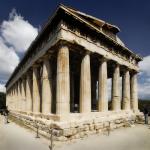|
This section contains 604 words (approx. 3 pages at 300 words per page) |

|
c. 650 B.C.E.–c. 590 B.C.E.
Musician
Choreographer
The Fame of Arion.
Arion was a master of mousike—dancing, poetry, and music—whose major period of activity was in the last half of the seventh century B.C.E. His fame has lived on, although none of his poetry has survived. He was a native of Methymna, a city-state on the island of Lesbos off the west coast of Turkey, but he spent much of his life at Corinth, where his patron was the tyrant Periander. During Periander's forty-year reign, Corinth was a brilliant center of art and culture, and among the artists attracted to his court was Arion.
Arion and the Dithyramb.
The dithyramb was a choral hymn, accompanied with dance, that was sung in honor of the god of wine Dionysus, and exactly what the music and dance were like before Arion is unknown...
|
This section contains 604 words (approx. 3 pages at 300 words per page) |

|




